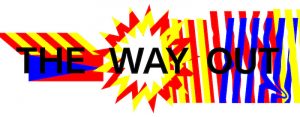Today’s art institutions are often stuck in a mode of imaginary participation, while real audiences might give these institutions a wide berth. Such self-isolation represents a huge blind spot of contemporary art, especially when it consists of social, activist, engaged, and participatory practices. Why don’t we as curators try to escape our comfort zones and safe spaces, refuse to be among our own all the time—whoever this “our own” might be—and give others the right to an aesthetic “otherness,” to fiction, theatricality, and perhaps naivete? Why don’t we tell more nuanced stories, whose moral is not so evident? Why don’t we stop knowing for sure what is good and what is bad?
These are questions that drive The Way Out, the 2021 edition of steirischer herbst, a festival with a long history of engagement with public space. It ventures radically out—outdoors, out of lockdown, but also out of the safe institutional bubble. How to bring art to non-initiated audiences? Can the popular be political without slipping into a populist trap?
This year’s opening takes place on Thursday, September 9, at the central station at Europaplatz, a site marking the literal entry and exit point of Graz, now transformed magically through an installation by Marinella Senatore.
Following an opening speech by director and chief curator Ekaterina Degot, visitors will hear a concertante teaser of an opera performance by Dejan Kaludjerović in collaboration with Marija Balubdžić, Bojan Djordjev, and Tanja Šljivar premiering the first weekend in one of Graz’s historical courtyards. For some years, Kaludjerović has been interviewing children in different countries on today’s most urgent political issues. For steirischer herbst ’21, he turns their poignant, hilarious, and insightful answers into an opera.
The scene is interrupted by performers who guide the audience to the Volksgarten park, where a new production by Flo Kasearu offers a surrealistic take on Graz’s street wardens and the new sociology of overregulation. The evening culminates on Hauptplatz, the city’s main square, with a new open-air stage production by Uriel Barthélémi with Sophie Bernado and Salomon Baneck-Asaro, in which hip-hop dance joins forces with polyrhythmic percussion to break through the isolation of different political and geographical zones.
The festival’s opening days also feature new situations by Tino Sehgal, who, together with forty interpreters, turns two parks into places of playful encounter, blurring the border between art and life. Artist group G.R.A.M. attempts a first step up and out of the clutter of public space, presenting a machine ballet to complement the sci-fi architecture of Kunsthaus Graz. In a timely installment of an ongoing work by Hiwa K, a special street kitchen bike takes to the streets of Graz, where participants are calling friends and relatives via video phone and cook their favorite dishes. A memorial by Thomas Hirschhorn taken care of by neighborhood locals celebrates the life and thought of philosopher Simone Weil, attaching itself to one of the city’s many public sculptures.
Each week of the festival is also accompanied by uniquely performative video reports from the streets and environs of Graz, shown online. In the first week, artist Lars “Jesus” Cuzner enlists a camera team on a mission to promote his newest work, a self-help confessional and potential bestseller. Other situation reports are contributed by Nicholas Grafia & Mikołaj Sobczak, Heimo Halbrainer and Joachim Hainzl (CLIO), Pia Hierzegger, and Stefanie Sargnagel.
In addition, the festival reaches out to the region of Styria. Working in three Styrian towns, director Felix Hafner broadens theater’s horizons by addressing local audiences as actors, delving into the motivations and potentials for protest in rural communities.
The festival’s Visitor and Press Center gives guests a place to meet and have coffee, but also serves as an artwork in its own right. This year, a former drugstore at Murgasse 6 is completely transformed through Peter Schloss and Grupa Ee’s mesmerizing installation. The Center also displays steirischer herbst’s newly commissioned artists posters, shown across town and available as an edition, which includes contributions by Nilbar Güreş, Hans Haacke, Horst Gerhard Haberl, Li Ran, Boris Mikhailov, Amanullah Mojadidi, Dana Sherwood, Mounira Al Solh, Piotr Szyhalski, and Rosemarie Trockel.
The future of curating and the new public ecology of exhibition-making are discussed at curatorial and artists’ roundtables on September 10, with the participation of Ekaterina Degot, Christoph Gurk, Flo Kasearu, Matteo Lucchetti, Christoph Platz, David Riff, Aneta Rostkowska, Sabina Sabolović, Tino Sehgal, and Mounira Al Solh, among others.
The festival continues until October 10 with a rich array of performances, urban interventions, and stage productions, including new works by Hito Steyerl and Mark Waschke, Reverend Billy and the Church of Stop Shopping, Sophia Brous with Faye Driscoll, Samara Hersch, and Lara Thoms, Žiga Divjak, Yael Bartana, and Theater im Bahnhof.
The Way Out of… is the title of an online lecture series, featuring Katherine Angel, Emma Dowling, Jason W. Moore, Evgeny Morozov, and Quinn Slobodian, freely accessible on the festival’s website.
The full program, including the varied Parallel Program by local art institutions, is available online.


